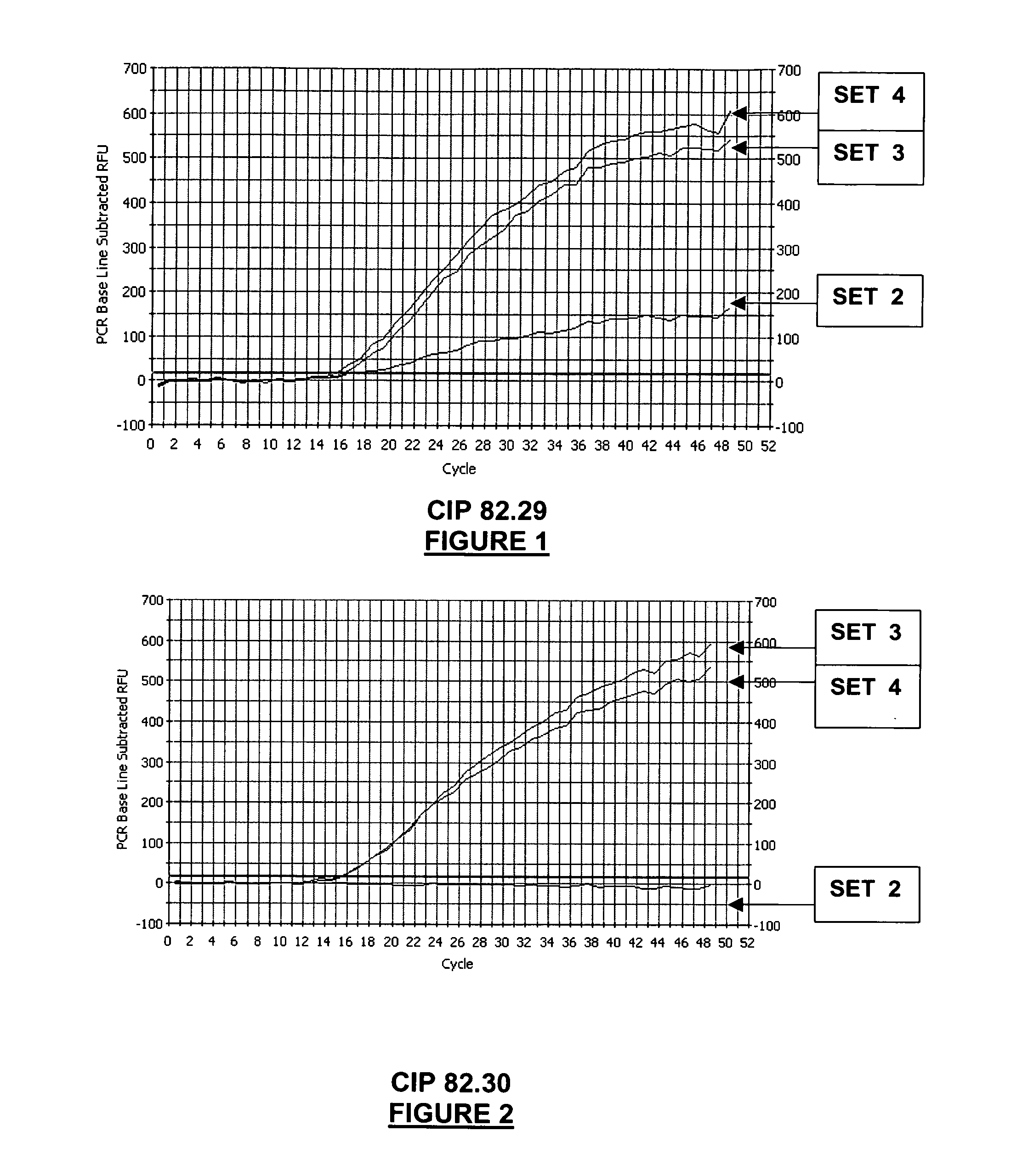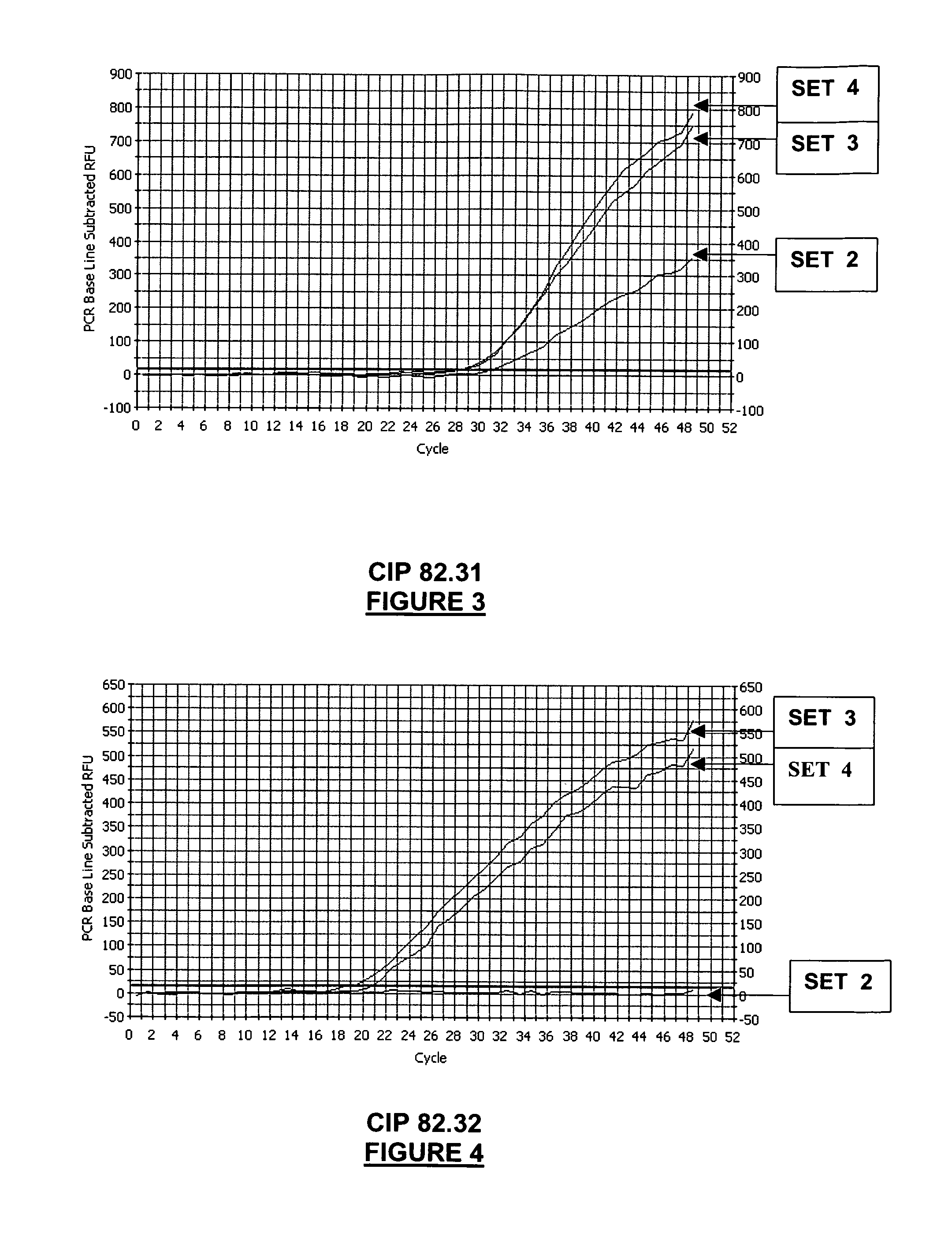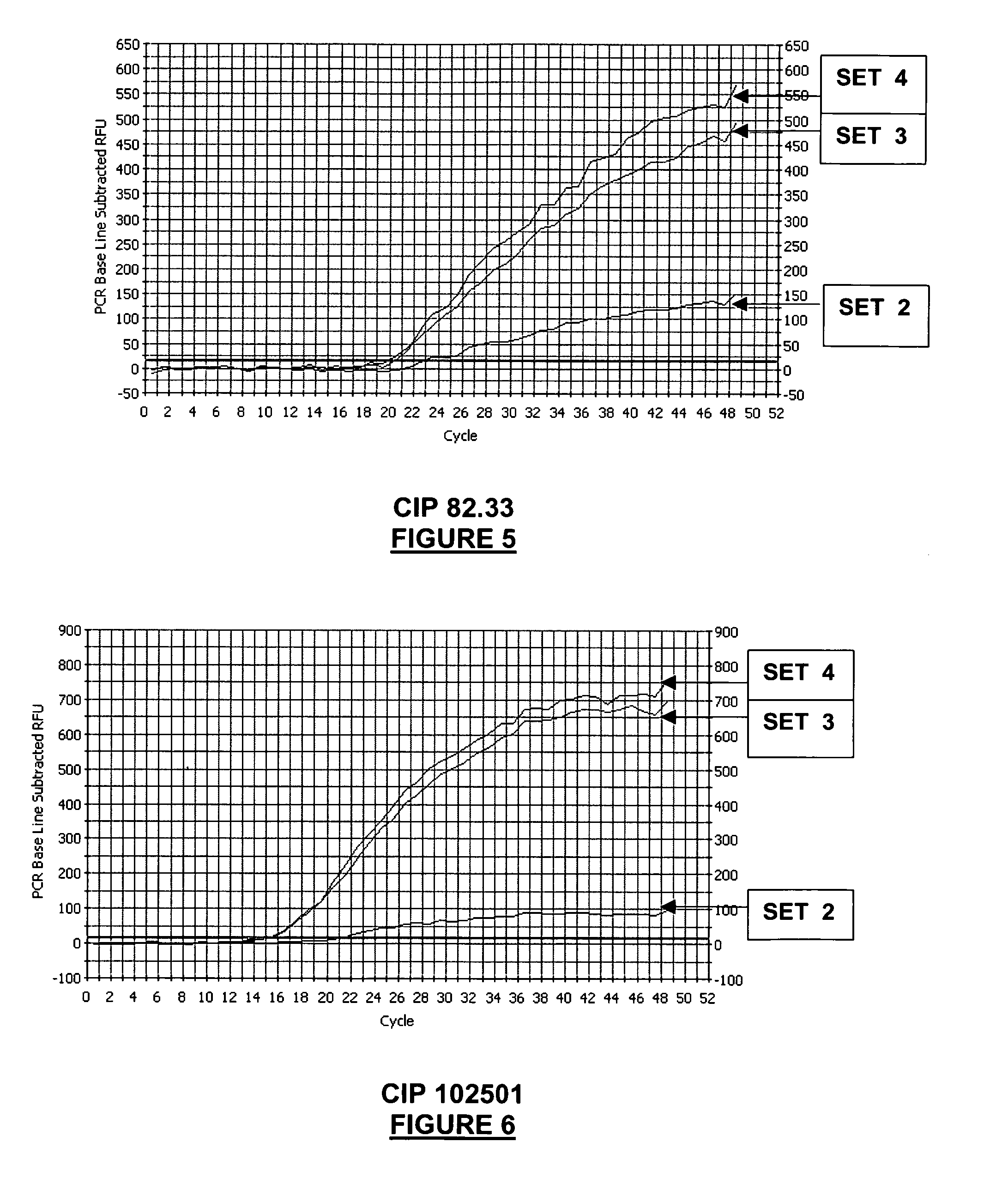Detection of salmonella by real-time multiplex PCR
a real-time multiplex and detection technology, applied in the field of detection of salmonella, can solve the problems of increasing the number of deaths and the problem of i>salmonella /i>, and achieve the effect of reducing the number of deaths and increasing the problem of salmonella detection
- Summary
- Abstract
- Description
- Claims
- Application Information
AI Technical Summary
Benefits of technology
Problems solved by technology
Method used
Image
Examples
example 1
(Comparative Example): Panel of Salmonella Strains
[0337]This example compares the Salmonella detection range (=inclusivity), and the sensitivity of different real-time PCR oligonucleotide sets.
[0338]A panel of reference Salmonella strains covering groups II, IIIa, IIIb, IV, VI, were assayed by real-time PCR, using four different sets of oligonucleotides:[0339]SET 1: primers SEQ ID NO: 1 and 3 (primers lag3-2 and lag6-2)+probe SEQ ID NO: 8 (probe CaptMod);[0340]SET 2: primers SEQ ID NO: 1, 2, 3, 4 (primers lag3-2, lag6-2, lag3-2C, lag6-2C1) and probe SEQ ID NO: 8 (probe CaptMod);[0341]SET 3: primers SEQ ID NO: 1, 2, 3, 4 (primers lag3-2, lag6-2, lag3-2C, lag6-2C1) and probe SEQ ID NO: 6 (probe MBSal1);[0342]SET 4: primers SEQ ID NO: 1, 2, 3, 4 (primers lag3-2, lag6-2, lag3-2C, lag6-2C1) and probes SEQ ID NO: 6 and 8 (probes CaptMod and MB Sal1).
[0343]Real-time PCR oligonucleotide sets 2, 3 and 4 are oligonucleotide sets of the invention, whereas real-time PCR oligonucleotide set 1 is...
example 2
(Comparative Example): Naturally-Contaminated Food Material
[0398]Ten samples of milk or fermented milk, which were susceptible of being naturally-contaminated by Salmonella, were collected for comparative analysis.
[0399]Each milk or fermented milk sample was treated as follows:
[0400]25 grams of milk sample were incubated with buffered peptone water at 37° C. for 20 hours. One milliliter of incubated medium was centrifuged to remove the supernatant. The pellet was submitted to DNA extraction with 200 μL of lysis buffer using the InstaGen matrix (Bio-Rad, Hercules, U.S.A.), as above-described in example 1.
[0401]Five microliters of extract were used for each Salmonella analysis.
[0402]Each of the ten extracts was analyzed:[0403]by cell culture, in accordance with the European Standard EN ISO 6579:2002 (International Standard ISO 6579:2002);[0404]by real-time PCR, using oligonucleotide set 1—which is not a set of the invention—(primers of SEQ ID NO: 1 and 3; probe of SEQ ID NO: 8);[0405]...
example 3
[0413]Table 7 below presents 58 strains that were tested with oligonucleotide SET 3 (see examples 1 and 2) for exclusivity study. DNA was extracted from a pure culture of each strain (in the appropriate culture conditions) with InstaGen Matrix, as described in examples 1 and 2. SET3 does not detect any of these strains.
TABLE 7StrainDeposit n°Shigella soneiATCC 25931Aeromonas hydrophilaCIP 76.14Aeromonas hydrophilaCIP 76.15Aeromonas hydrophilaCIP 107500Bacillus cereusATCC 11778Bacillus sphaericusDSMZ 28Bacillus subtilisATCC 6633Brochothrix campestrisDSMZ 4712Brochothrix thermosphactaDSMZ 20171Candida albicansATCC10231Citrobacter freundiiATCC 8090Citrobacter freundiiATCC 8090Corynebacterium bovisDSMZ 20582E. coliATCC 25922E. coliATCC 8739E. coli N° 44CIP 105243E. coli N° 46CIP 105245Enterobacter aerogenesATCC 13048Enterobacter cloacaeATCC 23355Enterococcus duransATCC 19432Enterococcus faeciumCIP 54.32Erysipelothrix rhusiopathiaeDSMZ 5055Escherichia coliDSMZ 30083Hafnia alveiCIP 57.31K...
PUM
| Property | Measurement | Unit |
|---|---|---|
| volume | aaaaa | aaaaa |
| temperature | aaaaa | aaaaa |
| temperature | aaaaa | aaaaa |
Abstract
Description
Claims
Application Information
 Login to View More
Login to View More - R&D
- Intellectual Property
- Life Sciences
- Materials
- Tech Scout
- Unparalleled Data Quality
- Higher Quality Content
- 60% Fewer Hallucinations
Browse by: Latest US Patents, China's latest patents, Technical Efficacy Thesaurus, Application Domain, Technology Topic, Popular Technical Reports.
© 2025 PatSnap. All rights reserved.Legal|Privacy policy|Modern Slavery Act Transparency Statement|Sitemap|About US| Contact US: help@patsnap.com



